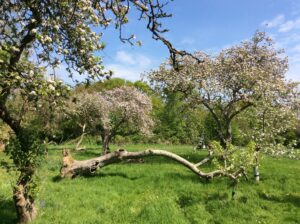What wildlife-rich looks like:
Fruit trees of all ages (but many veteran or ancient treesA tree that has reached a great age compared to others of the same species and has cultural, landscape or biodiversity value. Ancient trees are veteran trees, but not all veteran trees are old enough to be ancient. More) form part of a mosaic of habitats with flower-rich grasslands, patches of scrub, bushy hedges with trees and ponds. Managed without chemicals and fertilisers, they are hotspots for wildlife, providing habitat for insects, small mammals, nesting and foraging birds and bats, plants, lichens and fungi. Species such as lesser spotted woodpecker have increased and nest in Devon’s orchards again.



